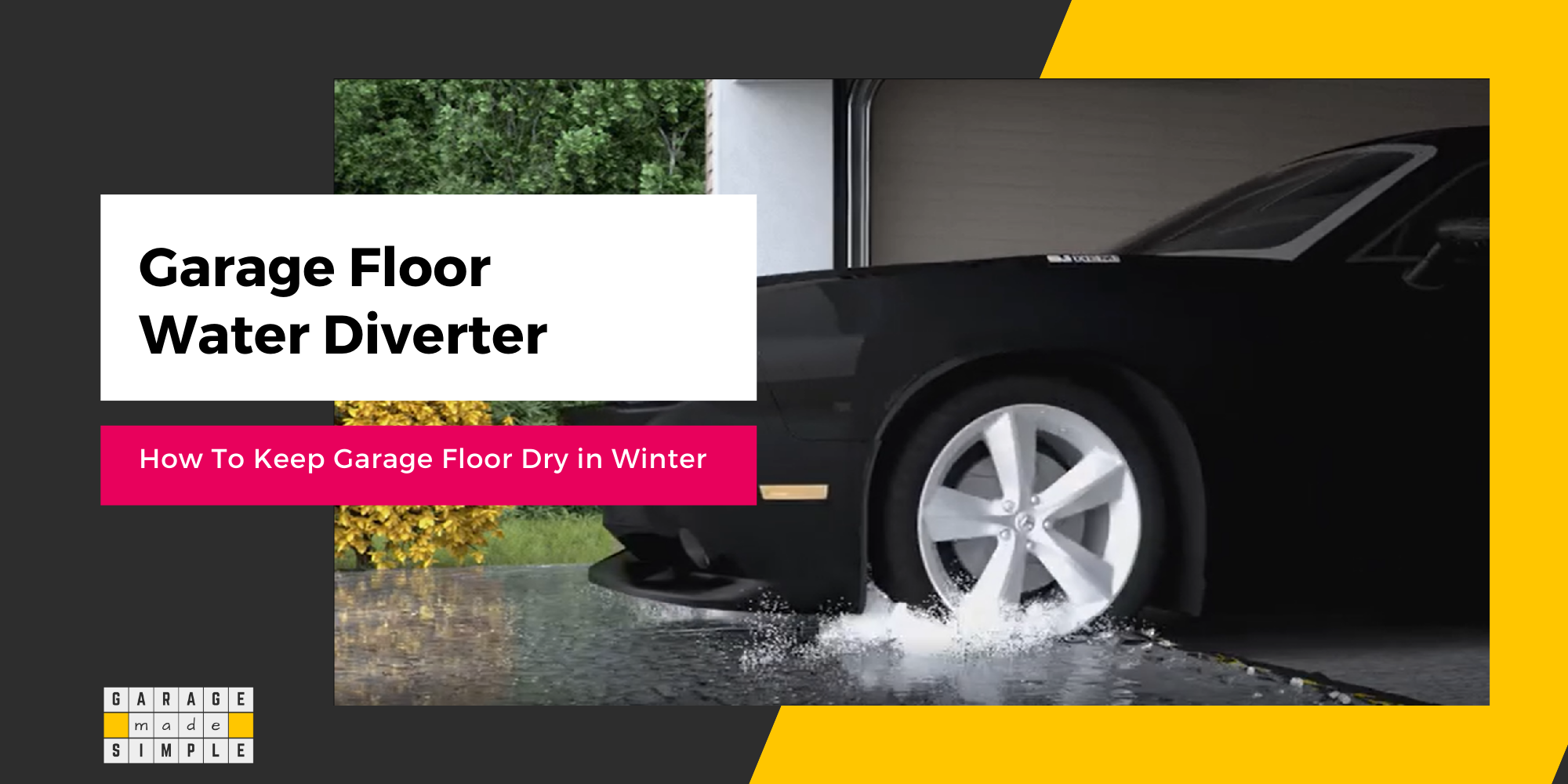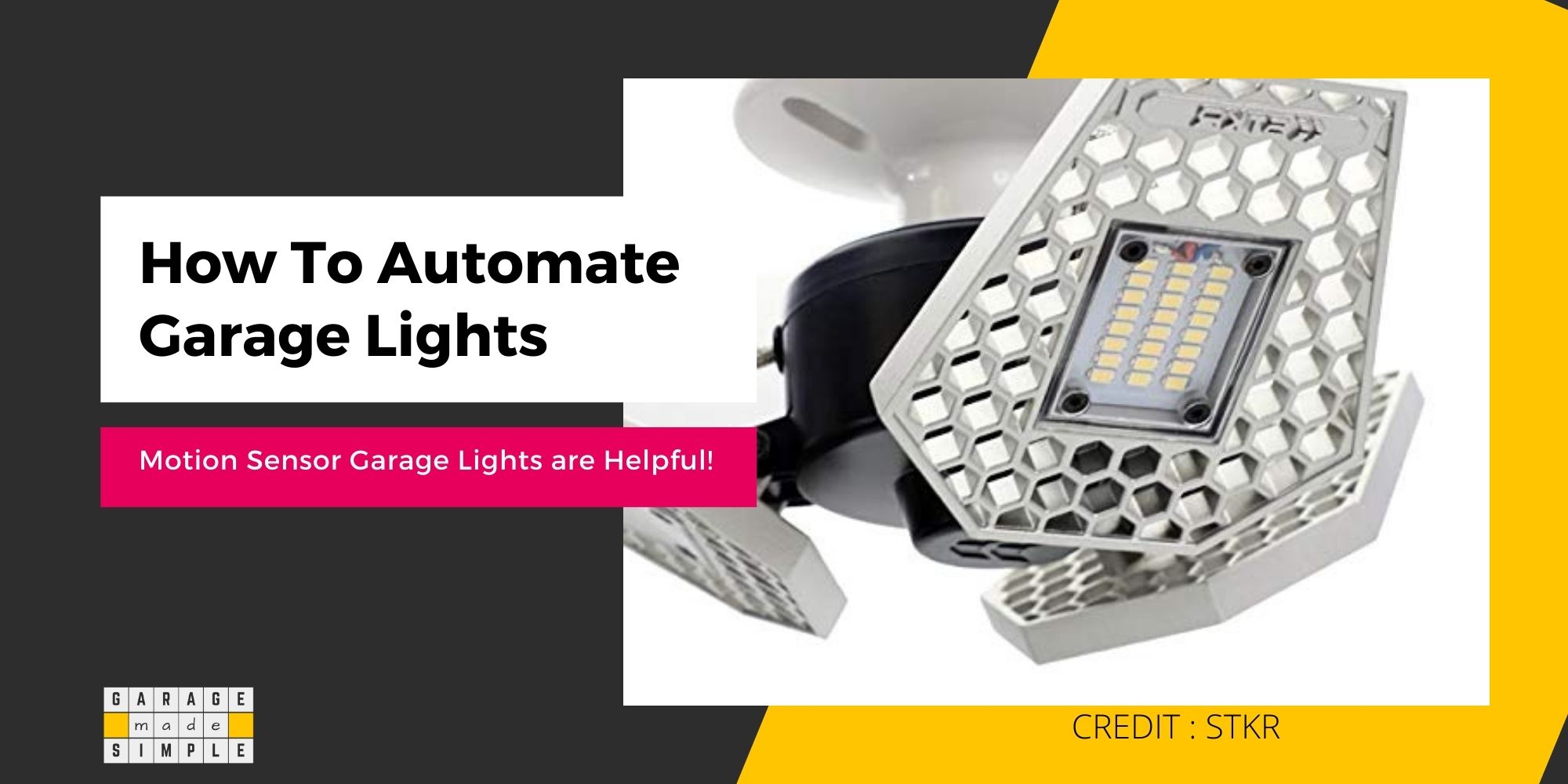Size of Exterior Lights on Garage Doors: The Easy Guide
garagemadesimple.com is a participant in the Amazon Services LLC Associates Program, an affiliate advertising program designed to provide a means for sites to earn advertising fees by advertising and linking to Amazon.com . The website is also an affiliate of a few other brands.
What Should be the Size of Exterior Lights on Garage Doors?
Whether it is a new house or a garage renovation project, the size of exterior lights plays an important role in creating the right ambiance after sunset. In many homes garage doors are a significant part of the façade.
Naturally, you want the exterior lights on garage doors to be just right. So what should be the size of exterior lights on your garage doors?
The size of exterior lights on a garage door is determined by the rule of thumb that the fixture should be between ¼ th to ⅓ rd the height of the garage door. As garage doors are typically 7’ high, garage door light fixtures should be between 21” and 28”.
The above works as a good guideline. In most cases, if you keep the size of exterior lights on garage doors between 21” and 28”, you will achieve a harmonious balance between all elements of your house facade.
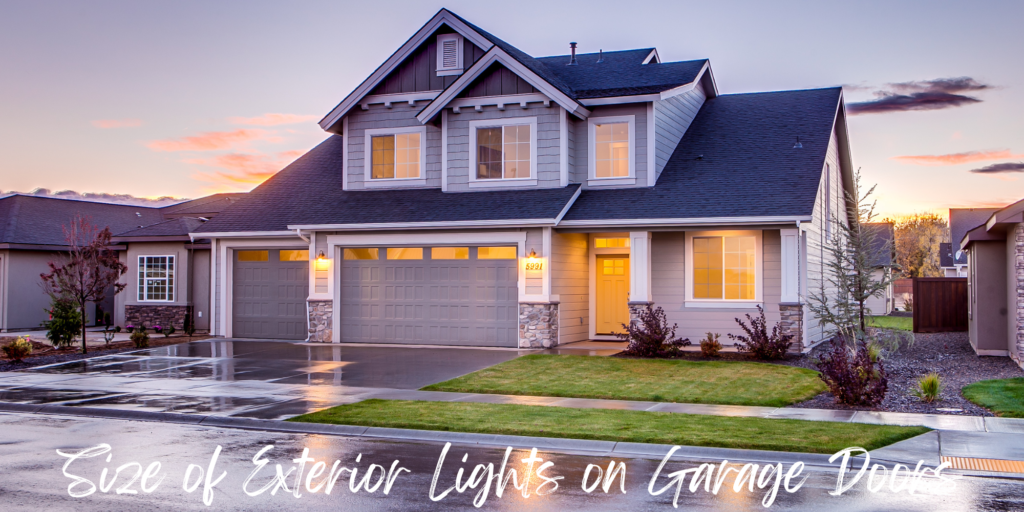
Exterior lights on garage doors have three key roles to play.
- Present a harmonious look to your entire house facade by maintaining the right balance between the size of exterior lights with other exterior elements such as doors, windows, porches, driveway, front yard landscaping, etc.
- Enhance the curb appeal of your home after sunset.
- Increase visibility and therefore safety in the area just outside the garage door. the
The size of exterior lights on your garage door should be chosen with care to ensure that they fulfill all of the above three roles.
For a new house or a major home façade renovation, it is a good idea to choose all the exterior light fixtures at the same time. Stick to the same brand. Most well known, high end brands have matching light fixtures for different sections of the façade, including garage doors.
How Do I Choose a Light for My Garage?
The size of exterior lights for your garage doors also depends on the size of the garage, number of light fixtures and their placement.
A two car garage with a double door (typically 16’ wide) is possibly the most common configuration. A smaller house may have a single car garage with a single door (typically 8’ wide). Larger houses may have a three or even a four car garage.
A three car garage can have three single doors or one single door and one double door. A four car garage door will most likely have two double doors, though other combinations are possible.
Exterior lights can be placed either on the sides or above the garage doors. Placements which combine the two are also possible and actually better for larger garages. The size of exterior lights depends on where it is placed in relation to the garage door.
There is a very large range of light fixture designs to choose from. Flush mount sconces, lantern or pendant designs, barn lights are some of the popular ones. The light fixture design also has a role to play in determining the size of exterior lights for garage doors.
Side mounted light fixtures should be small, if armless, but larger if with arms. Overhead singular light fixtures, with arms, can be considerably larger. Overall the size of exterior garage lights should stay between 21’ and 28”
Harmonizing Home Exterior Lights
Harmonizing home exterior lights is the art of blending good taste, warm ambiance with safety & security. Thoughtfully designed outdoor lighting enhances the architectural features of your home and surrounding landscape.
A harmonious design of home exterior lights, where no element is out of place, gives your home a cohesive, polished designer look.
You need to understand the importance of balance, proportion, and placement for each area of the home exterior, not just the garage doors, for you to create a harmonious and elegant lighting scheme for your home.
Here are how you should deal with the size of exterior lights and their placement in the different exterior areas of your home.
Front Door Wall Lights
Front door wall lights highlight the entrance, providing a warm and inviting ambiance for both residents and guests. Properly sized and placed front door lights are critical for creating a striking first impression.
Size: 1/4th or 1/3 the width of the door frame in inches.
Placement: Centered above door; 6″ above the door or at least 6” from door frame; 66″ from floor to center of fixture.
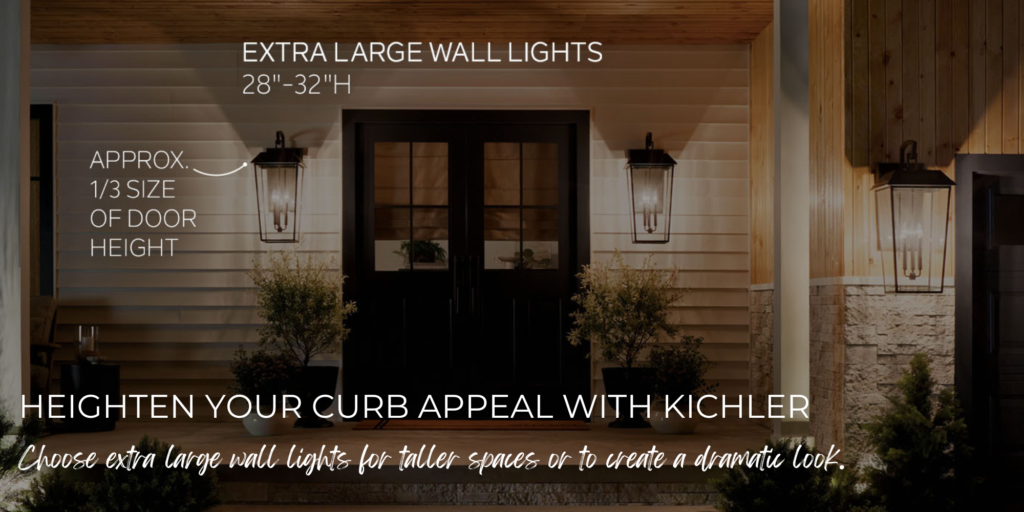
Shop for KICHLER Mathus 3-Light Olde Bronze Luxe Updated Traditional Outdoor Wall Light with Clear Glass for Outdoor Walls, Exterior Doors, Garage, Porch or Patio Walls for above look.
Front Door Wall Sconces & Carriage Lights
Front door wall sconces and carriage lights go above and beyond, adding a touch of elegance. They frame the doorway, emphasizing the architectural beauty of your home. Well-placed lights result in a subtle, tasteful glow that complements your home’s style.
Size: 1/4th or 1/3rd the height of the door in inches.
Placement: At least 6” from door frame; 66″ from floor to center of fixture.
Front Porch Ceiling Lights
Front porch ceiling lights provide functional illumination with a stylish flair. These lights create a cozy atmosphere, making your porch a delightful place to relax. Proper sizing and placement ensure uniform lighting, enhancing the porch’s charm while offering ample visibility.
Size: 1/4th or 1/3rd the width of the door frame.
Placement: Centered above door, 6″ above the door.
Front Entrance Hanging Lighting
Front entrance hanging lights are a statement piece, adding sophistication to your home’s exterior. These lights create a focal point, drawing attention to your entryway. Careful sizing and placement ensure they complement the door’s proportions, making a bold design statement.
Size: 1/5th the height of the door in inches.
Placement: Centered above door, 6″ above the door.
Driveway & Garden Lamp Post
Lamp posts along the driveway and garden add a touch of classic charm. They illuminate pathways and guide guests to your front door. These posts create a captivating visual effect, leading the eye towards your home. Proper sizing and placement enhance safety and create an enchanting ambiance.
Size: 1/4th the height of the mounting pole or fence post in inches.
Placement: At least 1’ from the driveway or street; 5.5′ to 6.5′ from ground to bottom of fixture.
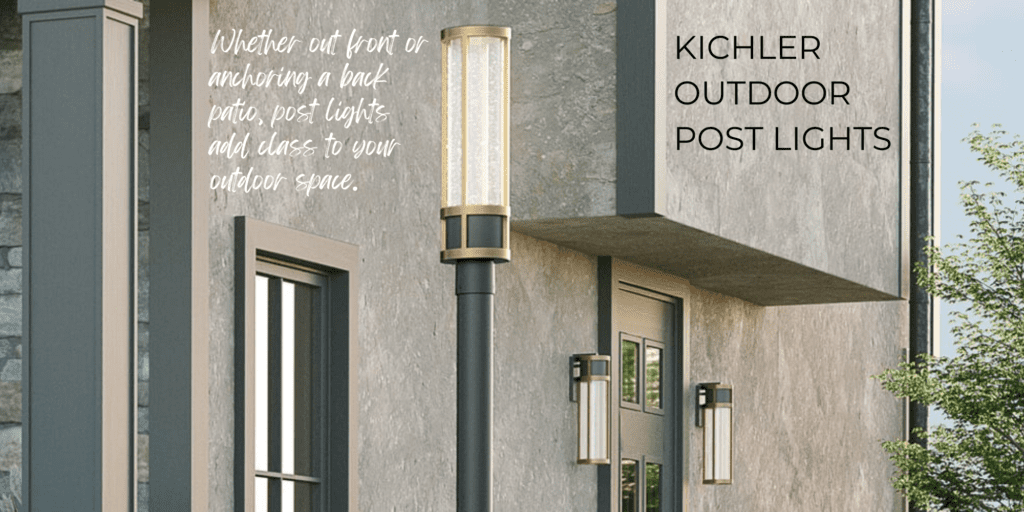
Shop for Kichler Barras 23.25″ 1 Light Outdoor Post Light with Clear Ribbed Glass in Black for a similar look.
Patio Dining Chandelier
A patio dining chandelier transform the outdoor dining area into an elegant space. The patio chandelier light can be the center of attention or just provide ambient lighting, creating a warm and inviting atmosphere.
A well-sized chandelier enhances the dining experience, adding a touch of luxury to your patio.
Size: 2/3 or 1/2 the width of the table in inches.
Placement: Centered above table or living area; 30-34″ above the table or 7’ above the ground.
By understanding the importance of each lighting area and following these guidelines, you can create a cohesive and visually appealing lighting design for your home and elevating its overall curb appeal.
Of course, this is only a guideline and exceptions, depending on the actual situation, are always possible.
How Bright Should Exterior Garage Lights Be?
Bright exterior lights on garage doors illuminate the driveway and make the garage a safer place. It is not unknown for thieves to lurk in the dark shadows and sneak into the garage as you are busy parking.
On the other hand, very bright exterior lights take away ambiance. Soft lighting will not create a glare and will actually highlight some of the noteworthy design features while keeping the not so notable ones in the dark.
You need to maintain a fine balance when it comes to choosing between illumination & security vs mood lighting & curb appeal. A practical way to achieve this balance is by going for more light sources of low brightness as opposed to a few light sources with high brightness.
How Many Lumens Do I Need for Outside Garage Lights?
Lumen is a measure of the actual amount of light that is produced by a light source. This should not be confused with the energy consumed by the light source. The energy consumed is measured in watts.
Light Source Technology has been evolving. In the beginning, light bulbs used only Incandescent Light (invented by Thomas Edison). Then came Fluorescent Light and now we have LED (Light Emitting Diode).
The light-emitting diode (LED) is today’s most energy-efficient and rapidly-developing lighting technology.
energy.gov
As a rough estimate, for the same lumen output, an LED bulb consumes just 10% of what an incandescent bulb consumes.
To measure the illuminance, we use the unit of “footcandle”. This can be measured using a handheld light meter, such as the BTMETER.
Around 400 lumens will be enough to illuminate the area outside a single car garage. Use a 400 lumen LED bulb if your light fixture is placed above and in the center of the garage door. Use two 220 lumen LED bulbs if you have two light fixtures, one on each side of the door.
For larger garages, increase the lumens in the same ratio as the garage door width. You should complement the garage door lighting with driveway lighting and landscape lighting.
This way you can increase the illuminance in front of the garage and actually enhance the curb appeal of your home!
Warm & Cool Light is the color of the light emitted. Warm light is white light with a yellow undertone while cool light is white light with a blue undertone.
The measure is Kelvin, which ranges from 2700K to 6500K. Lower end of the scale is warm light and the higher end is cool light.
Warm light is great for creating a mellow ambiance. It works very well with traditional architectural styles and lots of landscaping!
Use the thumb rules and guidelines but do not be restricted by them. Feel free to use your creativity and spirit of adventure!!
DISCLAIMER: What Is the Safest Way to Handle Electrical Wires?
This post is for information only. I strongly recommend that all electrical work should be entrusted to licensed professional electricians. In case you do decide to do some of the work yourself, make sure that:
“Treat all electrical wiring, even “de-energized” ones as if it is live, unless it has been locked out and tagged”
You must follow the basic safety guidelines, as under:
- Use protective eyewear, especially when drilling or grinding metal
- Wear insulated rubber gloves when working on any circuit or branch circuit
- Always use insulated tools while working with electricity
- De-energize the electrical wires on which you will be working. Tag the circuit breaker to prevent someone from switching it on accidently
- Electrical wiring in wet or damp locations or underground must be within a PVC conduit
- Underground wiring conduits should be at least 18 inches below grade as per code
- All receptacles for equipment that could be in wet or damp locations should be equipped with Ground Fault Circuit Interrupter (GFCI)
- Never use old frayed cables, damaged insulation or broken plugs
- High voltage equipment should be properly grounded to insure electricity flows directly to the ground and not through the person in contact with the live wire
Thank you very much for reading the post. I do hope you found it informative and useful.





